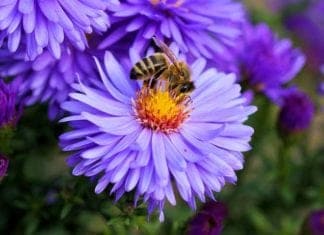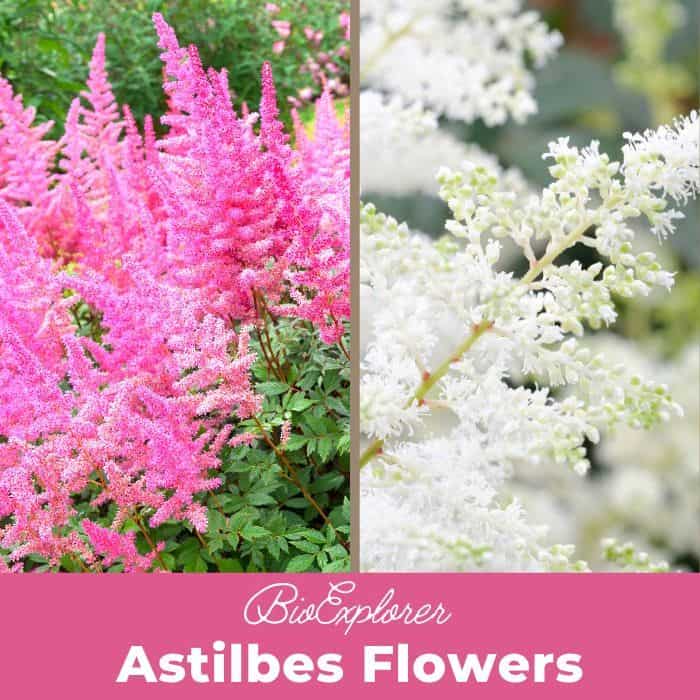
Astilbe Flowers: Astilbes are a genus of perennial, flowering plants native to Asia and North America. They are known for their vibrant, feathery plumes and fern-like foliage, adding elegance and color to any garden. Astilbes are particularly popular among gardeners due to their shade tolerance, allowing them to thrive in garden areas where many other plants struggle.
Their long-lasting, fluffy flower spikes come in various colors, including pink, orange, red, purple, and white, providing a stunning visual display throughout summer. In addition, their attractive, deeply cut foliage provides interest even when the plants are not in bloom, making them a valuable addition to any garden.
Astilbes[1] are also appreciated for their hardiness and low maintenance requirements. In addition, they can adapt to various soil conditions and are resistant to most pests and diseases. These qualities and their aesthetic appeal make Astilbes a favorite choice among novice and experienced gardeners.
The Genus Astilbe
The genus Astilbebelongs to the family Saxifragaceae and includes about 18 to 20 species[2].
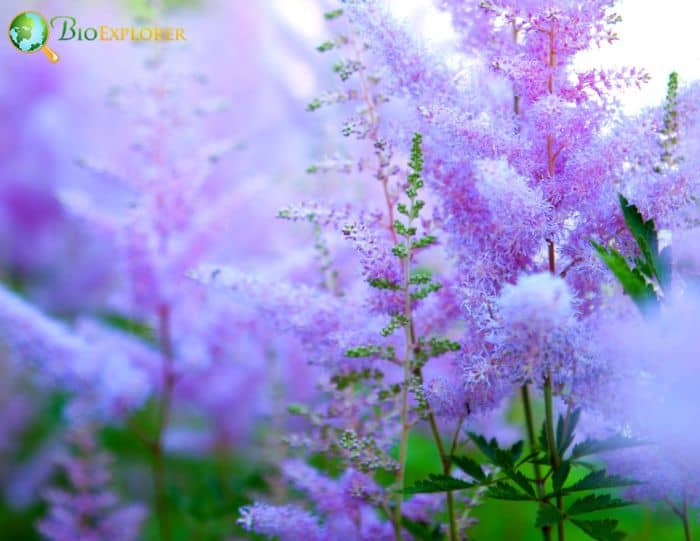
- These perennials are native to the mountain ravines and woodlands of East Asia and North America.
- Astilbes are characterized by their clump-forming habit and their feathery, plume-like flowers tower above their fern-like foliage.
- They are herbaceous perennials, meaning they die back to the ground in winter and grow back in the spring.
- Depending on the species and variety, Astilbes typically grow between 1.5 to 5 feet tall, making them a great choice for a variety of garden settings.
Suggested Reading:
Exploring the Top 50+ Most Exquisite Purple Flowers in the World
![]()
Brief History and Origin of Astilbe
Japan first distributed Astilbe flowers in the late 1800s, and the white flowering japonica species were shared.
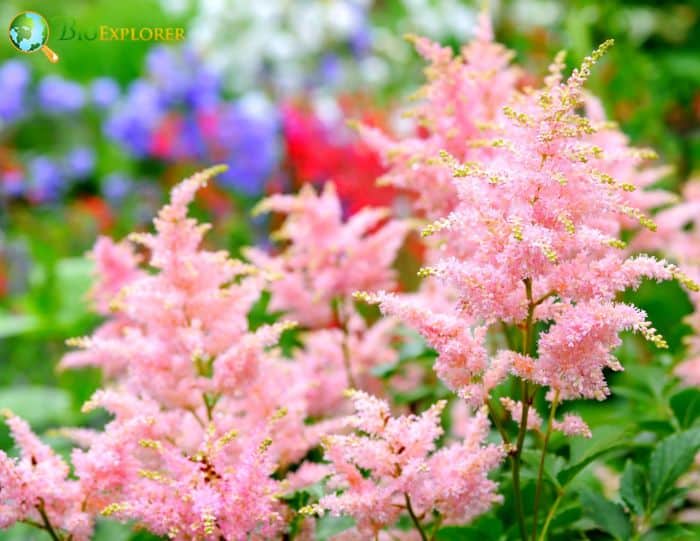
- Astilbe’s original birthplace lies in Japan[3] and China’s woody, mountainous peaks. Then they were formally introduced in the United States in the early 20th century.
- German botanist George Arends discovered Astilbe and began to crossbreed the first two species of Astilbe, namely japonica and davidii. The latter is the first pink variety in a sea of pure white. Arends continued to cross the species and their descendants until he raised bolder, more distinct variations.
- His first two prodigies were to be ‘Queen Alexander’ and ‘Peach blossom‘. Arends continued to cultivate this striking perennial during the 1920s and 30s. His most popular cultivar, released in 1933 with the name ‘Fanal’, is still a favorite among gardeners today[4].
- Astilbe flowers were not discovered in the late 18th century but in the late 19th century.
- However, they were introduced to the Western world in the 19th century, and breeders developed numerous hybrids and cultivars, expanding the range of flower colors, plant sizes, and foliage types available.
![]()
The Botanical Characteristics of Astilbe
Astilbes are herbaceous perennials with a clump-forming habit.
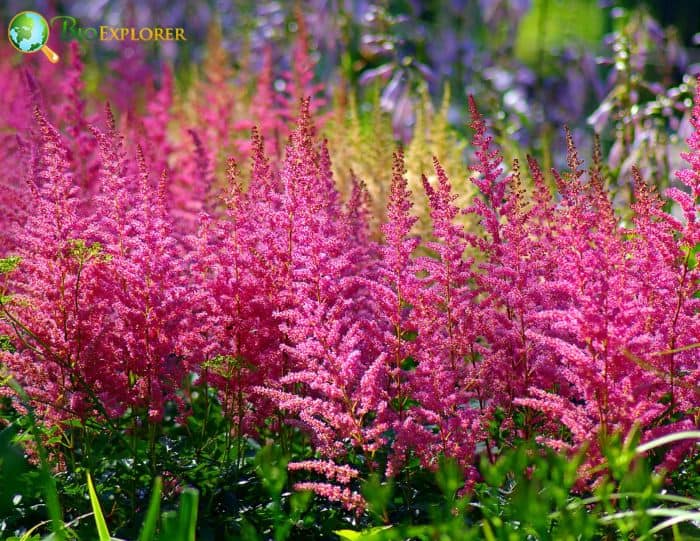
- They have compound, fern-like leaves that are usually deeply divided. The leaves are often glossy and range from green to bronze, depending on the variety[5].
- The flowers of Astilbe are borne on tall, erect, or arching stems and form feathery plumes. The individual flowers are small but are densely packed on the plume, creating a fluffy appearance.
- Flower colors include white, orange, pink, red, and purple.
![]()
Types of Astilbes
There are numerous varieties of Astilbe, each with its unique characteristics. Here are some of the most popular types of Astilbes:
- ‘Chocolate Shogun’ Astilbe: This type (Astilbe thunbergii) is known for its rich, chocolate-purple foliage and light pink blooms. The contrast between the dark leaves and the light flowers creates a striking visual effect. Chocolate Shogun’ is a compact variety perfect for small gardens or containers.
- ‘Color Flash’ Astilbe: This Astilbe (Astilbe arendsii) features foliage that changes from bright green to bronze, copper, and russet as the season progresses. The changing colors add a dynamic element to the garden. ‘Color Flash’ is a versatile plant that adds color to any garden.
- Dwarf Chinese Astilbe: Also known as Astilbe chinensis’Pumila’, this low-growing variety has glossy green foliage and lavender blooms. It’s an excellent ground cover for shady areas. The compact size and attractive blooms of the Dwarf Chinese Astilbe make it a popular choice for borders and rock gardens.
- ‘Fanal’ Astilbe: This (Astilbe × arendsii ‘Fanal’) is one of the best red-flowering types, with dark red flowers on reddish-bronze leaves. The intense color of the blooms makes ‘Fanal’ a standout in any garden. It’s a compact variety that’s perfect for borders or containers.
- ‘Federsee’ Astilbe: This variety (Astilbe x arendsii’Federsee’) bears dense Rose-pink blooms and has better drought tolerance than most Astilbes. The robust nature and beautiful blooms of ‘Federsee’ make it a great choice for gardens in drier climates.
- ‘Superba’ Chinese Astilbe: Astilbe chinensis var. taquetti’Superba’, this large plant bears magenta flowers on shiny, dark green leaves. The tall, vibrant blooms of ‘Superba’ make it a showstopper in any garden.
- ‘Visions’ Chinese Astilbe: This type of Astilbe has fern-like, bronze-green foliage and fragrant raspberry-pink blooms[6]. The fragrant flowers and attractive foliage of ‘Visions’ make it a favorite among gardeners. It’s a compact variety that’s perfect for borders or containers.
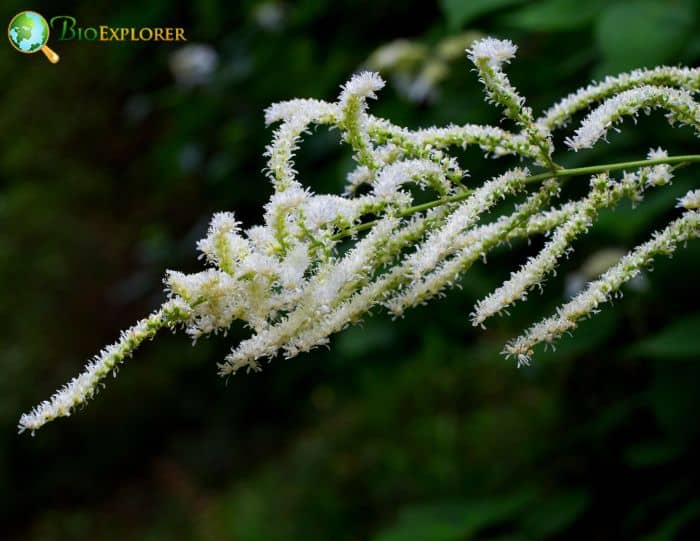
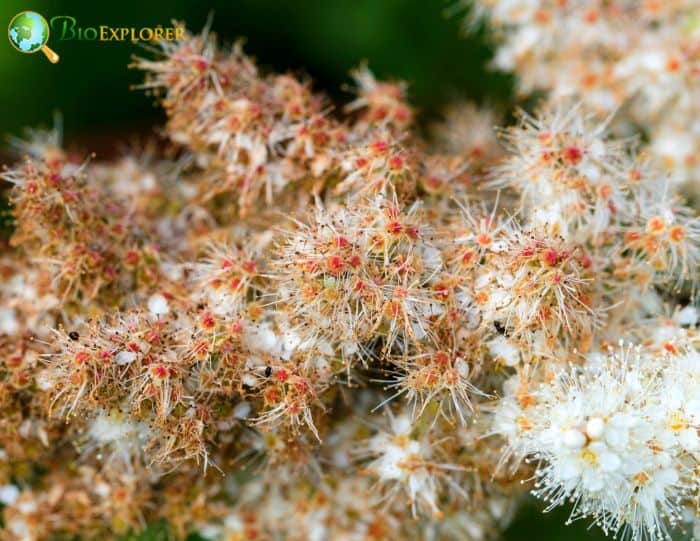
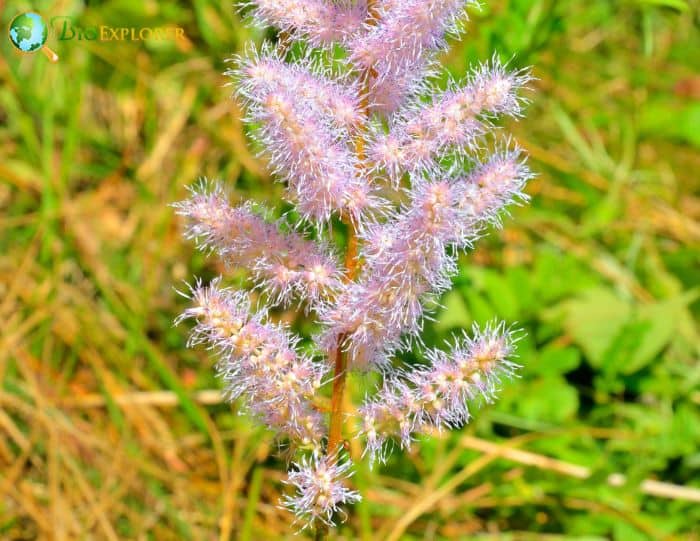
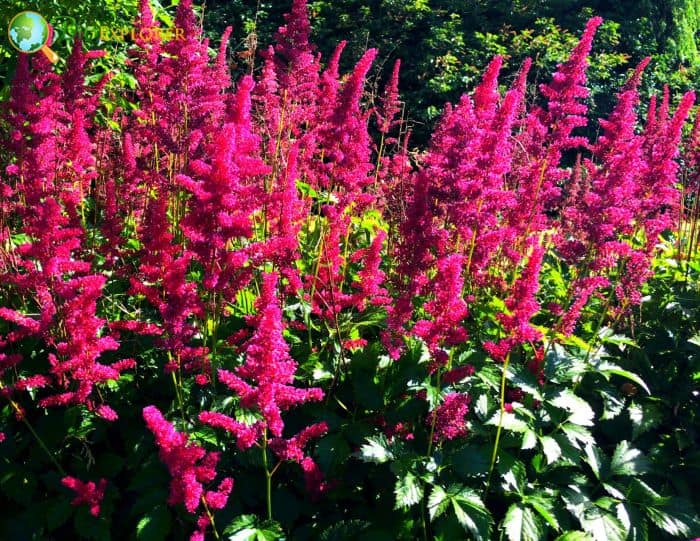
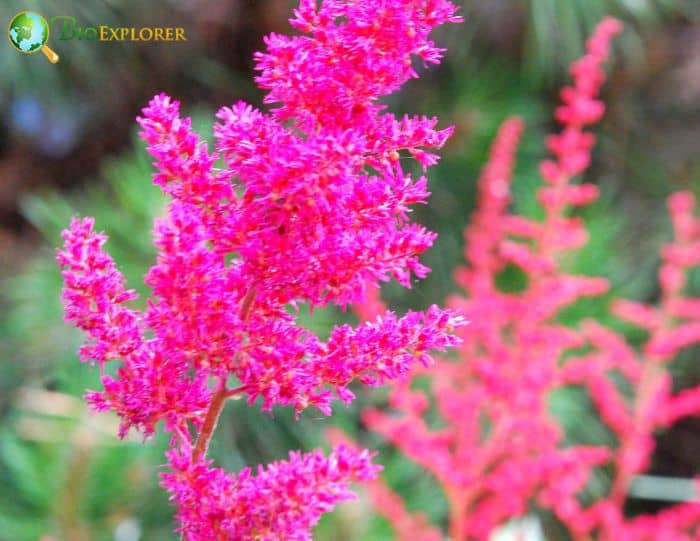
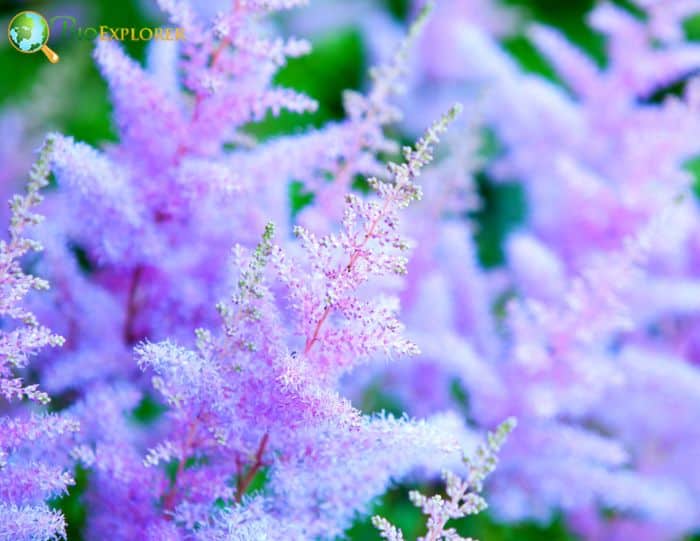
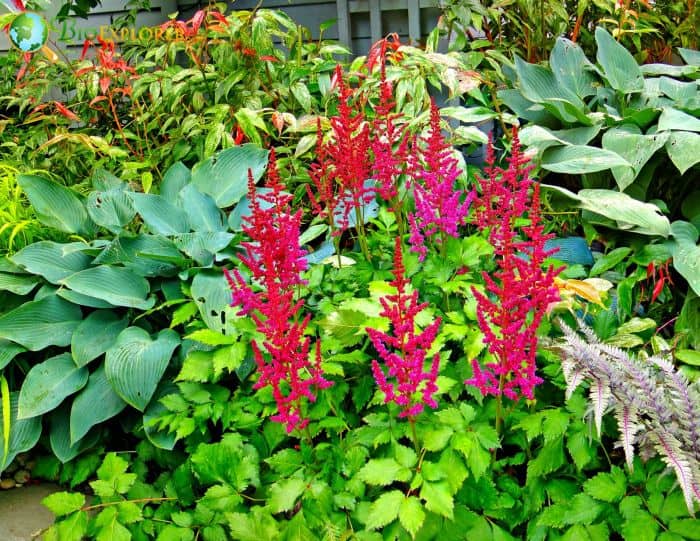
Each Astilbe variety brings unique charm to the garden. So, whether you prefer the rich, dark foliage of ‘Chocolate Shogun’, the changing colors of ‘Color Flash’, the compact size of Dwarf Chinese Astilbe, the intense red blooms of ‘Fanal’, the drought tolerance of ‘Federsee’, the tall, vibrant blooms of ‘Superba’, or the fragrant flowers of ‘Visions’, there’s an Astilbe variety to suit every preference.
![]()
Ideal Conditions for Growing Astilbes
Astilbes are versatile plants that adapt to various growing conditions. However, to thrive and bloom to their full potential, they do have certain preferences.
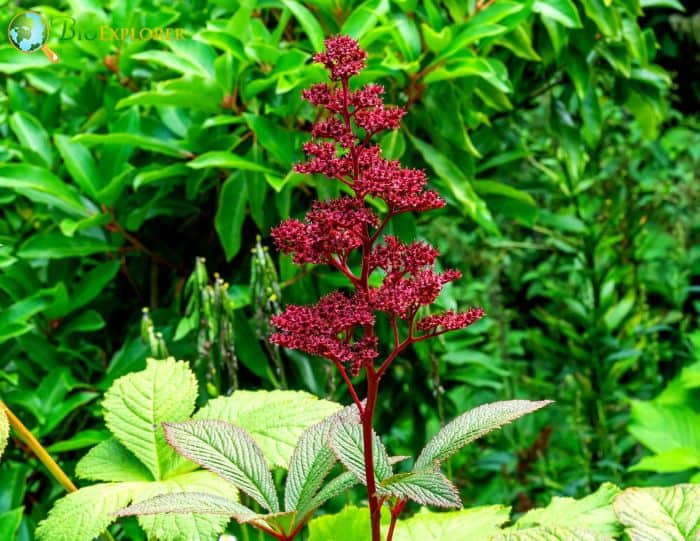
- Regarding light requirements, Astilbes can tolerate various conditions from full shade to partial sun. However, they bloom best when they receive gentle morning or dappled sun for about an hour or two each day. Too much direct sunlight can scorch the leaves and cause the plants to dry out.
- As for soil and water requirements, Astilbes prefers soil rich in organic matter and well-draining soil. They require consistent moisture and do not tolerate drought well. Therefore, watering should be regular, especially during dry periods. The soil should be kept consistently moist but not soggy. A mulch layer can help conserve moisture and keep the roots cool.
- The ideal climate for Astilbes[7] is a temperate one, with cool summers and mild winters. They are hardy in USDA zones 4 to 8. In hotter climates, they will need more shade and water to thrive. In colder climates, a thick layer of mulch can help to protect the roots from freezing temperatures.
- Regarding zones, Astilbes can be grown in a wide range of zones, from 4 to 9. However, they perform best in zones 5 to 7. In hotter zones, they will need more shade and water; in colder zones, they may need extra protection in winter.
![]()
Planting Astilbes
Astilbes should ideally be planted in early spring when the soil is cool and moist. This encourages the development of a robust root system before the heat of summer sets in.
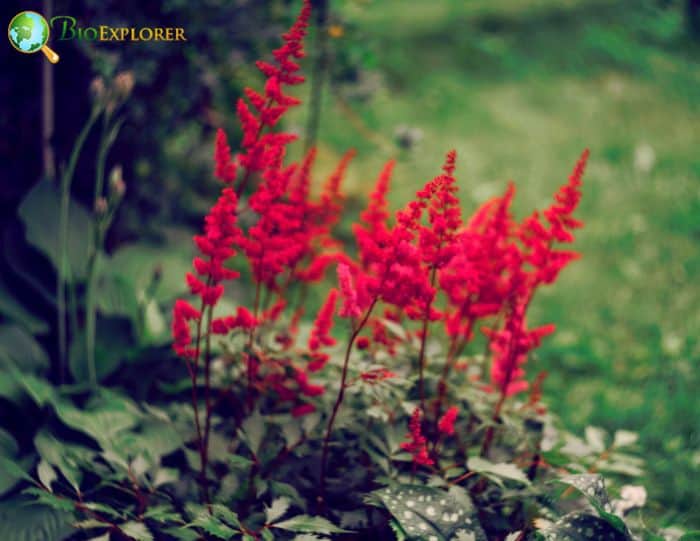
- To plant Astilbes, make a hole twice as wide and the same depth as the root ball.
- Place the plant in the hole, ensuring the top of the root ball is level with the soil surface. Backfill with soil, firming it gently around the base of the plant. Water thoroughly after planting[8].
- Astilbes can also be planted in the fall. Still, extra care should be taken to ensure they are well-watered and mulched before winter.
![]()
Propagation Methods
Astilbes can be propagated by division or from seed. The division is the most efficient method and can be done in late fall or early spring.
- The process involves gently separating and replanting a portion of the plant’s root structure. This not only propagates[9] new plants but also helps to rejuvenate older plants.
- Growing Astilbes from seed is also possible but requires more time and patience. The seeds should be sown indoors in late winter to early spring and transplanted outside after the danger of frost has passed.
![]()
Astilbe Care Tips
Astilbes are relatively low-maintenance plants that require care to keep them looking their best[10].
- Watering is crucial for Astilbes, especially during dry periods. The soil should be kept consistently moist but not waterlogged. During hot, dry weather, Astilbes may need to be watered daily. A mulch layer can help conserve moisture and keep the roots cool.
- Fertilizing should be done annually with a general-purpose granular fertilizer or compost to promote blooming. Apply the fertilizer in early spring, just as the plants grow. Be sure to water thoroughly after fertilizing to help the nutrients soak into the soil.
- Pruning involves removing spent flower plumes to encourage more blooms. This can be done as soon as the flowers start to fade. Then, the foliage can be cut back to the ground in late fall.
- Winter care for Astilbes involves protecting them from harsh winter weather. The plants in colder regions should be mulched in late fall to protect them from freezing temperatures. A thick layer of straw or shredded leaves works well. In spring, remove the mulch to allow new growth to emerge.
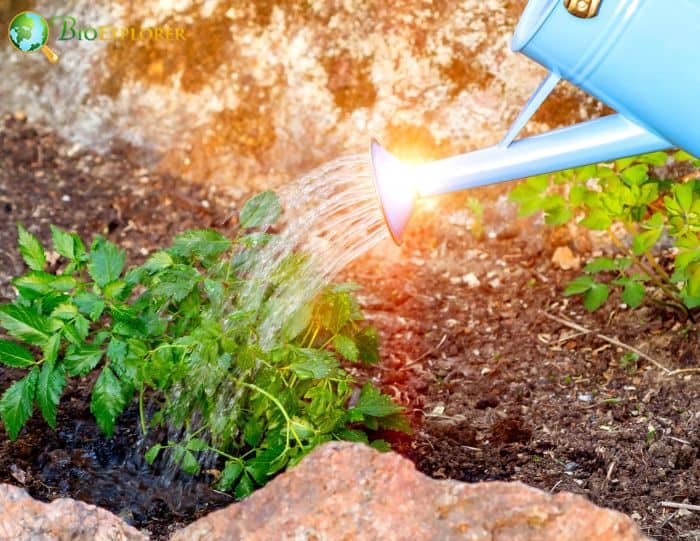
![]()
Common Issues and Solutions
Astilbes are generally resistant to most pests and diseases, but they can occasionally encounter some problems[11].
- One of the most common issues is powdery mildew. This fungal disease causes a white, powdery coating on the leaves[12]. This can be prevented by ensuring good ventilation around the plants and avoiding overhead watering. However, a fungicide treatment can be used if powdery mildew does occur.
- Astilbes can also be affected by aphids, small insects that suck the sap from the plants. Aphids can be removed by spraying the plants with a strong water jet or using an insecticidal soap.
![]()
Maintaining Healthy Astilbes
Maintaining healthy Astilbes involves providing the right growing conditions and regular care.
- They should be planted with partial shade and well-draining soil. Regular watering is crucial, especially during dry periods.
- Annual fertilizing with a general-purpose fertilizer or compost will help to promote blooming.
- Astilbes should be divided every 3-4 years to prevent overcrowding and keep them vigorous. This involves gently separating and replanting a portion of the plant’s root structure. Division can be done in late fall or early spring.
![]()


